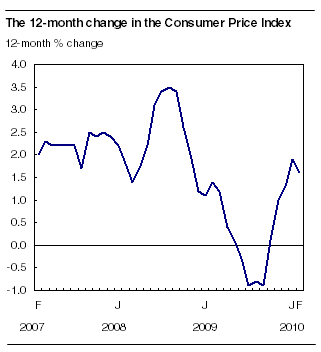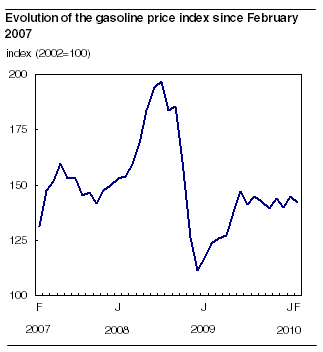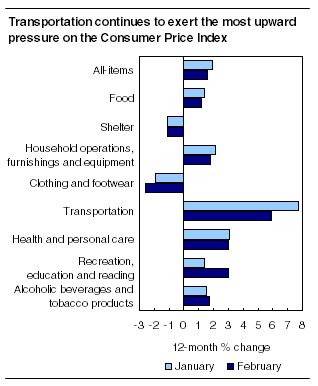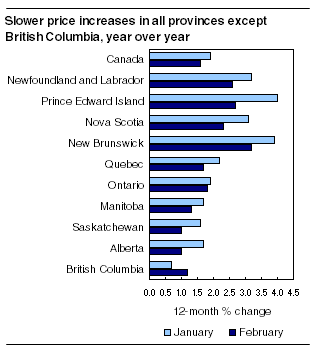Common menu bar links
Consumer Price Index
Archived Content
Information identified as archived is provided for reference, research or recordkeeping purposes. It is not subject to the Government of Canada Web Standards and has not been altered or updated since it was archived. Please "contact us" to request a format other than those available.
Related subjects
Consumer prices rose 1.6% in the 12 months to February, following a 1.9% increase in January.

Gasoline prices exerted the most upward pressure on the all-items Consumer Price Index (CPI) for a fourth consecutive month. In February, prices at the pump were 15.3% higher than they were in February 2009. This follows a 23.9% rise in the 12 months to January.
Prices at the pump in February 2009 were considerably lower than they were in late 2009 and early 2010. However, gasoline prices have been relatively stable since July 2009.

Overall, energy prices rose 4.0% between February 2009 and February 2010, following an 8.2% increase in the 12 months to January.
Excluding energy, the CPI rose 1.3% in the 12 months to February, matching the increase in January.
Prices for the purchase of passenger vehicles put upward pressure on the CPI for a second consecutive month in February.
As well, prices for traveller accommodation rose 16.0% in February, affected by the Winter Olympics.
Seasonally adjusted monthly CPI increases
On a seasonally adjusted monthly basis, the CPI rose 0.1% from January to February, after increasing 0.4% from December to January. February's increase was due mainly to a 1.8% rise in the recreation, education and reading component. Price increases for traveller accommodation largely accounted for the upward movement within this component.
12-month change: Six of the eight CPI components rise
Overall, six of the eight major components of the CPI recorded price increases in the 12 months to February. The exceptions were the shelter component, and clothing and footwear.

Prices in the transportation component continued to exert the strongest upward pressure on the all-items CPI, increasing 5.9% in February following a 7.7% rise in January.
In addition to higher gasoline prices, consumers paid 7.9% more for passenger vehicle insurance premiums. As well, prices for the purchase of passenger vehicles rose 3.5% in February, following a 3.1% increase in January. Car manufacturers continued to offer rebates to consumers, but to a lesser extent than they did at the same period a year earlier.
Prices in the recreation, education and reading component increased 3.0% in the 12 months to February. Consumers paid more for traveller accommodation, cablevision and satellite services and the purchase and operation of recreational vehicles. In contrast, prices fell for home entertainment equipment, parts and services and computer equipment and supplies.
Food prices advanced 1.2% in February following a 1.4% increase in January.
Upward pressure on the food index came mainly from prices for food purchased from restaurants (+2.6%). Price increases were also observed for dairy products and eggs (+1.4%). On the other hand, prices fell for fresh vegetables, fresh fruit and meat.
Prices for household operations, furnishings and equipment increased 1.8% in the 12 months to February. Upward pressure in this component came from prices for communications, other household goods and services, and child care and domestic services. Downward pressure came primarily from prices for furniture and household textiles and household appliances.
In the health and personal care component, prices rose 3.0% and were broad based. Prices for personal care increased 3.2%, while prices for medicinal and pharmaceutical products rose 1.9%.
Shelter costs declined 1.1% in the 12 months to February, mostly the result of declines in mortgage interest cost and natural gas prices.
The mortgage interest cost index, which measures the change in the interest portion of payments on outstanding mortgage debt, fell 5.8% in February, following a 5.5% decrease in January.
Upward pressure on the shelter component came from rent, cost of homeowners' maintenance and repairs, and fuel oil and other fuels.
Prices for clothing and footwear fell 2.6%. The strongest downward pressure in this component came from prices for women's and men's clothing. Prices for children's clothing also recorded a small decline in February.
Provinces: Slower price increases in most provinces
Growth in consumer prices slowed in all provinces except British Columbia between February 2009 and February 2010. In British Columbia, consumer prices rose 1.2%, compared with the 12-month increase of 0.7% in January.
As was the case in January, the largest year-over-year increases occurred in Atlantic Canada: New Brunswick, Prince Edward Island, Newfoundland and Labrador, and Nova Scotia.
Higher price increases in Atlantic Canada were partly attributable to larger upward movements in gasoline prices.
As well, prices for fuel oil and other fuels advanced 11.7% nationally in the 12 months to February, the largest increase since October 2008. These energy products are widely used in home heating in Atlantic Canada, while the rest of the country relies mostly on electricity and natural gas.

In Ontario, prices rose 1.8%. This was due primarily to higher prices for gasoline, passenger vehicle insurance, and the purchase of passenger vehicles. Downward pressure came mainly from the shelter and clothing and footwear indexes.
In Alberta, consumer prices went up 1.0%. Major contributors to higher prices were the cost of traveller accommodation and gasoline.
Prices in British Columbia increased mainly as a result of higher prices for traveller accommodation (+64.1%) and gasoline (+12.8%).
With the Winter Olympics, Canadians who travelled to Vancouver in February paid more for their hotel rooms compared with the same month a year earlier.
The recreation, education and reading index rose 7.4% in the 12 months to February, which was the largest contributor to the increase in the CPI for British Columbia. On the other hand, cost of shelter was the most significant downward contributor in that province.
12-month change in the Bank of Canada's core index
The Bank of Canada's core index advanced 2.1% over the 12 months to February, following a 2.0% rise in January.
February's increase was due primarily to price increases for passenger vehicles, as well as for traveller accommodation affected by the Olympics.
The seasonally adjusted monthly core index went up 0.3% in February, matching the increase in January.
For a more detailed analysis, consult the publication The Consumer Price Index.
Available on CANSIM: tables 326-0009, 326-0012, 326-0015 and 326-0020 to 326-0022.
Definitions, data sources and methods: survey number 2301.
More information about the concepts and use of the CPI are also available online in Your Guide to the Consumer Price Index (62-557-X, free) from the Key resource module of our website under Publications.
The February 2010 issue of The Consumer Price Index, Vol. 89, no. 2 (62-001-X, free), is now available from the Key resource module of our website under Publications. A paper copy is also available ($12/$111). A more detailed analysis of the CPI is available in this publication. See How to order products.
The March Consumer Price Index will be released on April 23.
For more information, or to enquire about the concepts, methods or data quality of this release, contact the Dissemination Unit (toll-free 1-866-230-2248; 613-951-9606; fax: 613-951-2848; cpd-info-dpc@statcan.gc.ca), Consumer Prices Division.
Table 1
| Relative importance1 | February 2009 | January 2010 | February 2010 | January to February 2010 | February 2009 to February 2010 | |
|---|---|---|---|---|---|---|
| Unadjusted | ||||||
| % change | ||||||
| All-items | 100.002 | 113.8 | 115.1 | 115.6 | 0.4 | 1.6 |
| Food | 17.04 | 121.2 | 122.3 | 122.7 | 0.3 | 1.2 |
| Shelter | 26.62 | 123.2 | 121.8 | 121.8 | 0.0 | -1.1 |
| Household operations, furnishings and equipment | 11.10 | 106.4 | 107.9 | 108.3 | 0.4 | 1.8 |
| Clothing and footwear | 5.36 | 93.6 | 90.1 | 91.2 | 1.2 | -2.6 |
| Transportation | 19.88 | 110.2 | 117.2 | 116.7 | -0.4 | 5.9 |
| Health and personal care | 4.73 | 110.4 | 113.8 | 113.7 | -0.1 | 3.0 |
| Recreation, education and reading | 12.20 | 101.1 | 101.1 | 104.1 | 3.0 | 3.0 |
| Alcoholic beverages and tobacco products | 3.07 | 129.2 | 131.1 | 131.4 | 0.2 | 1.7 |
| All-items (1992=100) | 135.4 | 137.0 | 137.6 | 0.4 | 1.6 | |
| Special aggregates | ||||||
| Goods | 48.78 | 107.3 | 108.4 | 108.5 | 0.1 | 1.1 |
| Services | 51.22 | 120.2 | 121.8 | 122.6 | 0.7 | 2.0 |
| All-items excluding food and energy | 73.57 | 110.8 | 111.6 | 112.4 | 0.7 | 1.4 |
| Energy | 9.38 | 127.2 | 133.9 | 132.3 | -1.2 | 4.0 |
| Core CPI3 | 82.71 | 112.8 | 114.4 | 115.2 | 0.7 | 2.1 |
Table 2
| Relative importance1 | February 2009 | January 2010 | February 2010 | January to February 2010 | February 2009 to February 2010 | |
|---|---|---|---|---|---|---|
| Unadjusted | ||||||
| % change | ||||||
| Canada | 100.002 | 113.8 | 115.1 | 115.6 | 0.4 | 1.6 |
| Newfoundland and Labrador | 1.27 | 113.4 | 116.5 | 116.3 | -0.2 | 2.6 |
| Prince Edward Island | 0.35 | 115.7 | 118.7 | 118.8 | 0.1 | 2.7 |
| Nova Scotia | 2.56 | 114.3 | 116.9 | 116.9 | 0.0 | 2.3 |
| New Brunswick | 1.97 | 112.0 | 115.4 | 115.6 | 0.2 | 3.2 |
| Québec | 21.05 | 112.3 | 114.0 | 114.2 | 0.2 | 1.7 |
| Ontario | 41.22 | 113.1 | 114.5 | 115.1 | 0.5 | 1.8 |
| Manitoba | 3.06 | 113.1 | 114.3 | 114.6 | 0.3 | 1.3 |
| Saskatchewan | 2.64 | 116.5 | 117.5 | 117.7 | 0.2 | 1.0 |
| Alberta | 11.43 | 121.5 | 122.3 | 122.7 | 0.3 | 1.0 |
| British Columbia | 14.29 | 111.9 | 112.2 | 113.2 | 0.9 | 1.2 |
| Whitehorse | 0.06 | 113.7 | 113.9 | 114.4 | 0.4 | 0.6 |
| Yellowknife | 0.08 | 114.5 | 116.8 | 117.4 | 0.5 | 2.5 |
| Iqaluit (Dec. 2002=100) | 0.02 | 111.8 | 111.3 | 111.1 | -0.2 | -0.6 |
Table 3
| Relative importance1 | December 2009 | January 2010 | February 2010 | December 2009 to January 2010 | January to February 2010 | |
|---|---|---|---|---|---|---|
| Seasonally adjusted | ||||||
| % change | ||||||
| All-items | 100.002 | 115.5 | 116.0 | 116.1 | 0.4 | 0.1 |
| Food | 17.04 | 121.9 | 122.1 | 122.3 | 0.2 | 0.2 |
| Shelter | 26.62 | 121.3 | 121.8 | 121.8 | 0.4 | 0.0 |
| Household operations, furnishings and equipment | 11.10 | 107.8 | 108.2 | 108.1 | 0.4 | -0.1 |
| Clothing and footwear | 5.36 | 92.6 | 92.2 | 91.7 | -0.4 | -0.5 |
| Transportation | 19.88 | 115.5 | 117.2 | 116.7 | 1.5 | -0.4 |
| Health and personal care | 4.73 | 113.4 | 114.0 | 114.0 | 0.5 | 0.0 |
| Recreation, education and reading | 12.20 | 103.7 | 103.6 | 105.5 | -0.1 | 1.8 |
| Alcoholic beverages and tobacco products | 3.07 | 131.2 | 131.1 | 131.4 | -0.1 | 0.2 |
| Special aggregates | ||||||
| All-items excluding food | 82.96 | 113.3 | 113.6 | 114.1 | 0.3 | 0.4 |
| All-items excluding food and energy | 73.57 | 111.8 | 112.3 | 112.6 | 0.4 | 0.3 |
| All-items excluding eight of the most volatile components | 82.71 | 113.2 | 113.6 | 113.9 | 0.4 | 0.3 |
| Core CPI3 | 82.71 | 114.5 | 114.9 | 115.3 | 0.3 | 0.3 |

